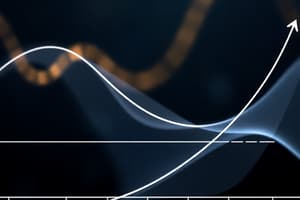Podcast
Questions and Answers
What factors contribute to sustainable economic growth?
What factors contribute to sustainable economic growth?
Factors include productivity, technological advancements, capital accumulation, and strong institutions.
How do business cycles affect economic stability?
How do business cycles affect economic stability?
Business cycles cause fluctuations in economic activity, leading to periods of growth (booms) and decline (recessions), impacting stability.
What are the effects of inflation on purchasing power?
What are the effects of inflation on purchasing power?
Inflation decreases the purchasing power of money, making goods and services more expensive over time.
What are the main types of unemployment?
What are the main types of unemployment?
What are the goals of fiscal policy?
What are the goals of fiscal policy?
How does monetary policy impact inflation?
How does monetary policy impact inflation?
What role does international trade play in macroeconomics?
What role does international trade play in macroeconomics?
How do income inequality and poverty relate to macroeconomic policies?
How do income inequality and poverty relate to macroeconomic policies?
What is the significance of a GDP growth rate of around 2%?
What is the significance of a GDP growth rate of around 2%?
What occurs during the peak phase of the business cycle?
What occurs during the peak phase of the business cycle?
What happens to businesses and employment during the contraction phase?
What happens to businesses and employment during the contraction phase?
How is the trough in the business cycle defined?
How is the trough in the business cycle defined?
What is meant by 'irrational exuberance' in relation to the stock market?
What is meant by 'irrational exuberance' in relation to the stock market?
What fiscal policy actions might the government take during an economic contraction?
What fiscal policy actions might the government take during an economic contraction?
How does the Federal Reserve influence the business cycle?
How does the Federal Reserve influence the business cycle?
What are the indicators of an economy overheating?
What are the indicators of an economy overheating?
What was the GDP growth rate during the peak preceding the 2008 recession?
What was the GDP growth rate during the peak preceding the 2008 recession?
Describe the role of tax and spending changes in fiscal policy.
Describe the role of tax and spending changes in fiscal policy.
What is demand-pull inflation and what causes it?
What is demand-pull inflation and what causes it?
How can cost-push inflation occur?
How can cost-push inflation occur?
What is the wage-price spiral and how does it relate to built-in inflation?
What is the wage-price spiral and how does it relate to built-in inflation?
What role do expansionary monetary policies play in inflation?
What role do expansionary monetary policies play in inflation?
How do inflation expectations impact consumer behavior?
How do inflation expectations impact consumer behavior?
What is imported inflation?
What is imported inflation?
Explain how market concentration can lead to inflation.
Explain how market concentration can lead to inflation.
What is the impact of fiscal policies on inflation?
What is the impact of fiscal policies on inflation?
How does high inflation affect purchasing power?
How does high inflation affect purchasing power?
List two consequences of high inflation on businesses.
List two consequences of high inflation on businesses.
What are the primary tools of monetary policy used to control inflation?
What are the primary tools of monetary policy used to control inflation?
Explain how central banks might use interest rates to combat inflation.
Explain how central banks might use interest rates to combat inflation.
What are the effects of inflation on income distribution?
What are the effects of inflation on income distribution?
What is the primary aim of fiscal policy?
What is the primary aim of fiscal policy?
How does government spending affect aggregate demand?
How does government spending affect aggregate demand?
What effect do tax cuts generally have on consumer spending?
What effect do tax cuts generally have on consumer spending?
What is a budget deficit?
What is a budget deficit?
How can contractionary fiscal policy help with inflation?
How can contractionary fiscal policy help with inflation?
What are the four phases of the business cycle?
What are the four phases of the business cycle?
What role does the Federal Reserve play in the business cycle?
What role does the Federal Reserve play in the business cycle?
What contributes to economic contraction?
What contributes to economic contraction?
What is economic expansion?
What is economic expansion?
What indicators does the NBER use to determine the business cycle phase?
What indicators does the NBER use to determine the business cycle phase?
What is a trough in the business cycle?
What is a trough in the business cycle?
How can institutional reforms help stabilize prices?
How can institutional reforms help stabilize prices?
What happens at the peak of the business cycle?
What happens at the peak of the business cycle?
Why is consumer and investor confidence important in the business cycle?
Why is consumer and investor confidence important in the business cycle?
Flashcards
Economic Growth
Economic Growth
Factors that lead to a country's long-term economic progress, considering productivity, technology, investment, and good governance.
Business Cycles
Business Cycles
Periodic ups and downs in economic activity, like booms and recessions, that affect many businesses and jobs.
Inflation
Inflation
A general increase in the prices of goods and services.
Unemployment
Unemployment
Signup and view all the flashcards
Fiscal Policy
Fiscal Policy
Signup and view all the flashcards
Monetary Policy
Monetary Policy
Signup and view all the flashcards
International Trade
International Trade
Signup and view all the flashcards
Income Inequality
Income Inequality
Signup and view all the flashcards
Demand-Pull Inflation
Demand-Pull Inflation
Signup and view all the flashcards
Cost-Push Inflation
Cost-Push Inflation
Signup and view all the flashcards
Wage-Price Spiral
Wage-Price Spiral
Signup and view all the flashcards
Expansionary Monetary Policy
Expansionary Monetary Policy
Signup and view all the flashcards
Reduced Purchasing Power
Reduced Purchasing Power
Signup and view all the flashcards
Monetary Policy Tools
Monetary Policy Tools
Signup and view all the flashcards
Interest Rates
Interest Rates
Signup and view all the flashcards
Open Market Operations
Open Market Operations
Signup and view all the flashcards
Reserve Requirements
Reserve Requirements
Signup and view all the flashcards
Tightening Monetary Policy
Tightening Monetary Policy
Signup and view all the flashcards
Loosening Monetary Policy
Loosening Monetary Policy
Signup and view all the flashcards
GDP Growth Rate
GDP Growth Rate
Signup and view all the flashcards
Overheating
Overheating
Signup and view all the flashcards
Irrational Exuberance
Irrational Exuberance
Signup and view all the flashcards
Peak
Peak
Signup and view all the flashcards
Contraction
Contraction
Signup and view all the flashcards
Trough
Trough
Signup and view all the flashcards
What is a recession?
What is a recession?
Signup and view all the flashcards
Expansion Phase
Expansion Phase
Signup and view all the flashcards
Contraction Phase
Contraction Phase
Signup and view all the flashcards
What influences the business cycle?
What influences the business cycle?
Signup and view all the flashcards
Role of Government
Role of Government
Signup and view all the flashcards
Government Spending
Government Spending
Signup and view all the flashcards
Taxation
Taxation
Signup and view all the flashcards
Budget Deficits & Surpluses
Budget Deficits & Surpluses
Signup and view all the flashcards
Contractionary Fiscal Policy
Contractionary Fiscal Policy
Signup and view all the flashcards
Expansionary Fiscal Policy
Expansionary Fiscal Policy
Signup and view all the flashcards
Remedies for Inflation
Remedies for Inflation
Signup and view all the flashcards
Study Notes
Macroeconomic Issues
- Macroeconomics studies large-scale economic issues impacting entire economies or sectors
- Key issues include economic growth, business cycles, inflation/deflation, unemployment, fiscal policy, monetary policy, international trade/finance, income inequality/poverty, government debt, and environmental sustainability
Economic Growth
- Focuses on factors driving sustainable long-term growth
- Examines productivity, technology, capital accumulation, and institutional factors
Business Cycles
- Analyzes fluctuations in economic activity (expansions/contractions)
- Understanding business cycles aids policymaking for economic stability
Inflation and Deflation
- Inflation is the sustained rise in the general price level
- Deflation is the decrease
- Controlling inflation is vital for stable prices and purchasing power
Unemployment
- Examines different unemployment types (frictional, structural, cyclical)
- Aims to reduce unemployment by addressing skills, flexibility, and support
Fiscal Policy
- Involves government revenue and expenditure (taxes, spending, borrowing)
- Aims for economic stability, growth, and wealth redistribution
Monetary Policy
- Central bank policies control money supply, rates, and credit
- Aims to regulate inflation, maintain stability, and influence activity
International Trade and Finance
- Examines global trade, exchange rates, balance of payments, capital flows
- Analyzes how global trends impact domestic economies
Income Inequality and Poverty
- Aims to reduce income disparity and poverty
- Seeks to ensure fair wealth distribution
Government Debt and Deficits
- Examines the impact of government borrowing, deficits, and debt on the economy
- Managing fiscal policy to control deficits and sustain debt is crucial
Environmental Sustainability
- Integrates environmental concerns into economic policies
- Addresses climate change, resource depletion, and sustainable development
Inflation Causes
- Demand-Pull Inflation: Increased demand exceeds supply, due to consumer/business/government spending, excessive monetary growth
- Cost-Push Inflation: Rising production costs (wages, raw materials, energy) or supply shocks (disruptions)
- Built-In Inflation: Wage-price spiral, where wage increases lead to price increases, and vice versa
- Monetary Factors: Expansionary monetary policies (lower rates, increased supply), currency devaluation
- Expectations and Psychology: Anticipated price increases leading to wage/purchase demands
- External Factors: Imported inflation due to changes in global markets or currency fluctuations
- Structural Factors: Lack of competition in certain sectors
- Government Policies: Deficit spending, price controls/subsidies
Consequences of Inflation
- Reduced purchasing power
- Uncertainty and planning challenges
- Redistribution of income/wealth
- Interest rate increases
- Distorted investment and saving behaviour
Monetary Policy
- Aim: Control inflation and economic stability through money supply and interest rates
- Tools: Interest rates, open market operations, reserve requirements
- Impact: Tightening policy reduces demand, loosening policy stimulates but can lead to inflation
Fiscal Policy
- Aim: Influence economic conditions via government spending, taxation, and borrowing
- Tools: Government spending, taxation, deficits/surpluses
- Impact: Contractionary policy reduces demand, expansionary policy stimulates but can lead to inflation
Remedies for Inflation
- Combining monetary and fiscal policies
- Long-term planning for stable growth
- Institutional reforms for effective regulation and competition
Business Cycle
-
Natural rise and fall of economic growth
-
Phases: Expansion (growth), peak (highest point before contraction), contraction (decline), trough (lowest point before expansion)
-
Factors influencing cycle: supply/demand, capital availability, consumer/investor confidence
-
Monitoring and influencing the cycle using monetary policy (Fed) and fiscal policy (government)
Studying That Suits You
Use AI to generate personalized quizzes and flashcards to suit your learning preferences.




